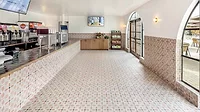Are You Ready? Starnet Looks Ahead to the Future of Commercial Flooring

Commercial flooring contractors captured a glimpse of what the future of their businesses could look like at Starnet’s Fall Meeting held October 13-15, 2023, in Louisville, Kentucky. The organization, with more than 180 members who are responsible for $4.4 billion in sales annually, come together each fall for training and professional development.
We caught up with Starnet President and CEO Mark Bischoff to learn about the evolutionary and revolutionary changes taking place in the commercial market today—and what commercial contractors need to know to prepare for the future. This interview has been edited for length and clarity.
FLOOR Trends & Installation: Tell us about the meeting.
Mark Bischoff: The theme of the meeting is “Step into the Winner’s Circle.” We’ve covered several topics with the membership: workforce development, recruiting and retention, technology deployment, productivity—both in the office and in the field—which is different from technology. Sometimes it includes technology, but a lot of times it's just a fancy new tool or fancy new machine, or a way to organize your business.
Then we are adding into technology the complication of artificial intelligence (AI) and its impact on not only our industry, the construction industry, but what it's going do to our stakeholders like architects and designers, real estate developers—anyone who's interested in the office environment for their business.
There are a lot of predictions about what it's going do with the workforce and how the changes are going be made. And we're a bit concerned as we're just getting through this with the back-to-office challenge and hybrid. It’s a concern of ours for what may happen, but it's also an opportunity for our members to get in on the front of it and make sure that they are securing their business in the right way to anticipate the impact on clients—and respond in their own business with how to help those clients with all those changes.
FLOOR Trends & Installation: Are your members ready?
Bischoff: We believe that based on historical behavior, it could be a long road. The threat is if our members ignore it, or they don't make a decision, they just wait on the sideline to see what happens, it could be devastating.
Look at the time and energy put into programming, selecting, communicating, approving, even doing renderings and concepts for clients. A skilled designer using AI to enhance what they do could do the work of four, five, six, seven, 10, 20 designers. We could do a concept, build it, and then deploy AI tools and say, I want a hundred variations of this.
Say part of my competitive advantage is I have eight highly trained, experienced estimators and an incumbent uses that as a moat around their business. They use it to be better than the next company. If you're a disruptor and you say, I don't have eight highly qualified estimators, can't afford it, I'm just starting. It's going to be me and this AI friend that I have. If your costs go to zero and you could bid the same amount of work as those eight—even if the machine is making mistakes within reason—you can make tons of mistakes and still be millions of dollars in costs below your competitors.
There's a clearly defined legal and process system for contract work. This is how you play the game. All that energy is just making little tweaks to the game that everyone knows in order to get just a little bit of an edge so you can beat your competitor. Now you don't have to spend all the time on that. You could go call on customers, you could negotiate work, you could do a thousand renderings. You could convince them that you've got the hybrid AI model figured out that you're going help them with all of their space.
That's how we're asking our members to redirect. You're going to have to change your story. Many of them have built their competitive advantage around the process of doing commercial work. Now they need to change their competitive advantage around what value are you providing a client that may not be fully invested in construction and commercial work.
FLOOR Trends & Installation: How are your members already embracing technology?
Bischoff: We have a lot of members deploying technology to do site monitoring. Floorcloud would be an example. [Editor’s Note: Floorcloud is a technology platform that enables general and specialty contractors to remotely monitor ambient interior floor space conditions in real-time, and communicate material-specific alerts, while storing data securely in the cloud.]
Some are doing third-party estimating and some are dabbling in AI estimating. My recommendation is if they have eight quality estimators, they should start to go into fresh jobs that they still have to execute, that their estimators have worked on, and run those jobs through the AI estimation so that they can compare.
FLOOR Trends & Installation: What are you doing to help them manage these pending changes in AI?
Bischoff: Our members have hundreds of millions of dollars invested in the front end of the business. Who reviews the contract? Who does the estimates? How much time are they in the business? How much time did they take? Who do you need to communicate with? That's the front end. Then you get the work and you have to execute it in the field. There’s some changes happening there, but that's still brute force. Then the back end, the closeout. How do you do the closeout documents? How's it communicated to get paid?
If [you have] a business model where you basically have 60% of your costs in field labor and 40% in everything else, and that 40 goes to zero, well, if you're deployed right, you take advantage of it, you're more profitable. You could do more work. You may say, I can either exponentially increase the compensation, the tools deployed, I can buy lots of machinery that may not have made sense in another financial model.
As far as I'm concerned, this has been going for decades. We're just stepping into it. It's just starting to become real. This is our first real shot to the members at this fall meeting. We believe that the spring meeting of 2024 is going to be full of all of this and much more in depth, much more in detail with potential action plans and steps to take and products and vendors that are relevant.
FLOOR Trends & Installation: What else do we need to know?
Bischoff: The other good news about Starnet is the Next Gen group is very strong. We had a workshop to talk about succession planning—how do we transfer inside the family business? There's a lot of father-daughter teams, which is cool.
The reality is these businesses are not small anymore. If you're a Starnet commercial flooring contractor, these are big businesses. It used to be, I'm a $4 million contractor, I'm a $5 million contractor. Now, I’m a $25 million or $50 million or $75 million contractor. We have a lot of members in the $20 to $50 million range, and that is a serious business.
Looking for a reprint of this article?
From high-res PDFs to custom plaques, order your copy today!




